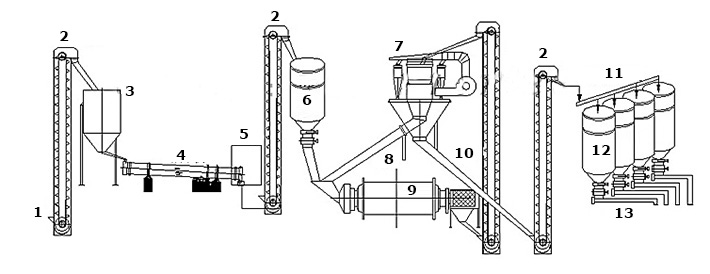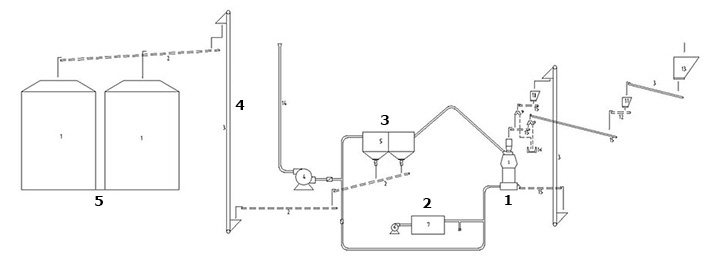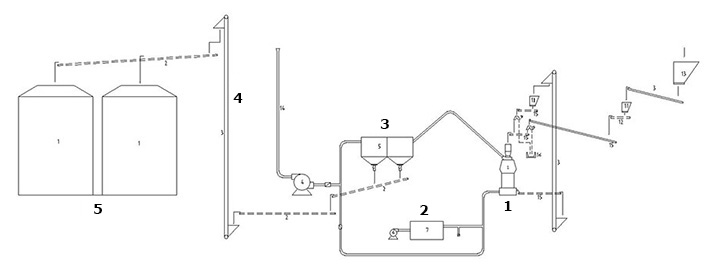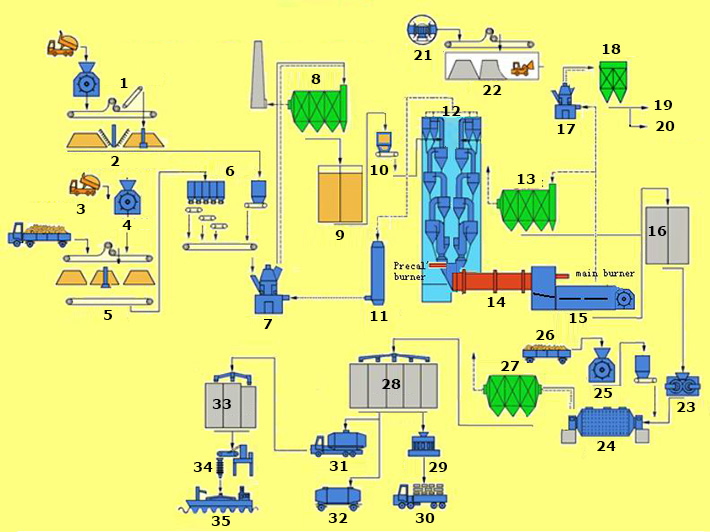Power Plant Solution
I. Conceptual Design
Pulverized Coal Production Process Plan Drawing
1. Vertical Roller Mill
2. Blast Furnace
3. Dust Collector
4. Elevating Conveyor
5. Pulverized Coal Bin
II. Required Equipment
Vertical Roller Mill
III. Solution Advantages
1. One single vertical roller mill consumes as little as 18-22 Kwh of electricity for each ton of pulverized coal produced. Wear-resistant parts of the mill ensure an extended use life. The mill is quite efficient at separating large coal particles from fine powder. It is able to produce narrower size distribution than is required under related standards.
2. A reasonable overall structure is a tangible guarantee of stable operation, ease use, and reliable control. This mill brings 30% electricity savings compared with a traditional ball mill. Its fuel economy reaches industry-leading standards.
3. High size-reduction ratio allows the mill to suitable for feedstock of HGI55~60 grindability. The mill is able to function properly under both high and low loads.
4. Noise control level meets the Emission Standard for Industrial Enterprises Noise at Boundary (GB12348-2008).
5. The average dust concentration in the surrounding atmosphere is lower than 1mg/m3, meeting the Emission Standard of Air Pollutants for Cement Industry (GB4915-2004).
Benefits
1. Pulverized coal is easier to burn than lumpy coal. It saves 30% of electricity, meeting the related national standards.
2. During grinding, the grinding roller does not contact directly with the grinding table. This grinding method reduces wear, extends parts use life, and saves production cost.
3. Normally speaking, the mill would produce 5 to 70 tons of powder coal in an hour. Percentage of coal particles larger than 80μm is as low as 3%.
Grinding Station Solution
I. Solution
Grinding Process Design
1. Feedstock
2. Bucket Elevator
3. Silo
4. Baking Machine
5. Blast Furnace
6. Homogenizer
7. Separator
8. Coarse Material
9. Ball Mill
10. Fine Material
11. Screw Conveyor
12. Cement Silo
13. Screw Conveying Process
II. Required Equipment
Vertical Roller Mill for Cement
Vertical Roller Mill for Slag Powder
III. Solution Advantages
1. 30% Constructed Area Savings and 40%-50% Space Savings
Our vertical roller mill comes with a separator that uses hot air from the engine to transport the powder out of the mill and directly into the dust collector. This grinding method is rather simple, and hence the mill using this method can have a low failure rate, high production efficiency, and compact lay-out. It fits nicely in the small allotted space in your factory.
2. 80dB Noise Level
There is no direct contact between the grinding roller and rotating grinding table during grinding operation, This ensures minimum noise level that meets the Emission Standard for Industrial Enterprises Noise at Boundary (GB12348-2008). Generally speaking, our vertical roller mill maintains a noise level 20dB-25dB lower than an ordinary ball mill.
3. Dust Concentration Less than 1 mg/ m3
Our vertical roller mill a one-piece fully-sealed steel casting. It kicks up little dust under conditions of negative pressure. Its dust emission level meets the Emission Standard of Air Pollutants for Cement Industry.
4. Low Wear Rate
Traditional ball mill loses 500g of its parts for grinding each ton of cement clinker. Our vertical vertical roller mill, however, only wears down by 4-6g for the same amount of grinding task. This difference of wear rate between these two mills is mainly due to the fact that there is no direct contact, let alone collision, between metal parts in a vertical roller mill. Hence, the vertical roller mill is always a wise choice for it lasts longer, runs more steadily, and saves more production cost.
5. PC42.5 Cement with specific surface area of 3300~3800 cm2/g
Via adjusting the rotary speed of the separator, wind speed, and roller pressure, users can acquire powder of different finenesses. Even more convenient, powder finer than the required size can be moved out of the mill in time. This avoids over-grinding.
Benefits
1. On average, it only takes 1 to 3 years for a vertical roller mill to pay for itself.
2. The vertical roller mill uses the most advanced grinding techniques and process to bring users more than 30% power savings.
3. Taking into account all the money spent on initial construction, operation and maintenance, the vertical roller mill costs 20% to 30% less than a ball mill.
4. With our vertical roller mills, users can produce 55 to 250 tons of cement per hour. The resulting cement powder has a specific surface area of 3300~3800 cm2/g.
Steel Mill Solution
I. Solution
Slag Powder Production Process Plan Drawing
1.Vertical Roller Mill
2. Blast Furnace
3. Dust Collector
4. Elevating Conveyor
5. Slag Powder Silo
II. Equipment
Vertical Roller Mill for Slag Powder Vertical Roller Mill for Coal
III. Advantages
1. 20%~30% Electricity Savings (Compared to Ball Mill)
The vertical roller mill relies on the principle of multiple layers of materials grinding against one another. It uses little electricity to perform grinding operation. The more moisture the material contains, the more electricity savings the vertical roller mill will achieve.
2. Noise Control Meeting the Emission Standard for Industrial Enterprises Noise at Boundary (GB12348-2008)
In a ball mill, steel balls keeps colliding with each other as well as falling down on the liners, creating loud noise. This is contrasted with our vertical roller mill, which generally has a noise level 20dB-25dB lower than the ball mill.
3. Dust Concentration Less Than 1 mg/m3
Our vertical roller mill is a one-piece fully-sealed steel casting. It generates little dust when working at negative pressures. Its dust emission level meets the Emission Standard of Air Pollutants for Cement Industry (GB4915-2004).
4. 0.5%-1.0% Moisture Content in Finished Products
Hot air is used to transport finely ground particles out of the mill. Users can increase the inlet air temperature when handling materials that contain much moisture.
5. 5~10g/t Low Wear Rate
There is no direct contact between metal parts in a vertical roller mill. This results in low wear rate, long service lifetime and reduced production costs.
6. 4200~4500 cm2/g Specific Surface Area
Materials being ground only stay for a short time in the mill. It is easy to inspect and control the particle size and chemical composition. This reduces the need to re-grind large particles, ensuring users get consistently good-quality powder.
7. 50% Space Savings Compared to a Ball Mill
The vertical roller mill simplifies the grinding process with a simple, small-footprint structure. It can be placed outside your factory, thereby reducing the factory area requirements.
Benefits
1. It generally takes 1 to 3 years for a vertical roller mill to pay for itself.
2. Optimized grinding process and process control allow the mill to save 30%-50% electricity.
3. It takes less time to build a vertical roller mill related project. This results in time savings.
Mine Solution
I. Solution
Vertical-Roller-Mill Involved Production Process Plan Drawing
1. Vertical Roller Mill
2. Blast Furnace
3. Dust Collector
4. Elevating Conveyor
5. Finished Product Bin
II. Equipment
Vertical Roller Mill Ball Mill
III. Advantages
1. Our vertical roller mill is very compact and takes up 50% to 60% less space than an ordinary ball mill. It can be placed outside the factory, thus reducing the factory construction cost.
2. The vertical roller mill saves 30%-40% electricity compared to a ball mill while generating 20dB lower noise and meeting the Emission Standard for Industrial Enterprises Noise at Boundary. (GB12348-2008)
3. Its one-piece, fully-sealed structure prevents dust from running out of the mill, maintaining a dust concentration lower than 1 mg/m³ in the surrounding atmosphere when working at negative pressures. Its dust emission level meets the Emission Standard of Air Pollutants for Cement Industry. (GB12348-2008)
4. Automatic control system allows users to easily control the mill from a distance. Regular inspection of the hydraulic cylinder as well as frequent replacement of roller coating and liner via turning the swing arm can reduce the risk of mill breakdown which might lead to heavy economic loss.
5. Materials being ground only stay for a short time in the mill. It is easy to inspect and control the particle size and chemical composition. This reduces the need to re-grind large particles, ensuring users get consistently good-quality powder.
Benefits
1. Advanced grinding process and techniques allow the mill to save more than 30% of electricity.
2. Taking into account all the money spent on initial construction, operation and maintenance, the vertical roller mill costs 20% to 30% less than a ball mill.
3. With our vertical roller mills, users can produce 70 to 720 tons of cement per hour. The percent of ground particles larger than 80μm falls between 12-15%.
Cement Plant Solution
I. Solution
Cement Plant Process Plan Drawing
1. Limestone Crusher
2. Limestone Pre-Homogenization Yard
3. Cement Additive Entering the Factory
4. Crusher
5. Cement Additive Storage Yard
6. Batch Metering
7. Ball Mill for Cement Raw Material
8. Dust Collection
9. Cement Raw Material Homogenization Silo
10. Feedstock Metering
11. Humidifier Tower
12. Pre-heater
13. Electrostatic Precipitation
14. Rotary Kiln
15. Cooler
16. Cement Clinker Silo
17. Ball Mill for Coal
18. Coal Dust Collection
19. Going to the Rotary Kiln
20. Going to the Pre-Calciner
21. Raw Coal Entering the Factory
22. Coal Storage Yard
23. Vertical Roller Mill
24. Ball Mill for Cement Clinker
25. Crushing
26. Gypsum Entering the Factory
27. Cement Dust Collection
28. Cement Silo
29. Cement Packer
30. Bagged Cement Transported by Car
31. Bulk Cement Transported by Car
32. Bulk Cement Transported by Train
33. Silo at the Port
34. Ship-loader
35. Bulk Cement Transported by Ship
II. Equipment
Vertical Roller Mill for Slag
Vertical Roller Mill for Coal
Rotary Kiln
Vertical Roller Mill for Cement
III. Advantages
1. Worldwide Service and Mature Solution
As a global supplier of grinding system, Great Wall Machinery uses experience in product design, process control and energy efficiency management to provide customers from cement industry with high-quality, integrated cement grinding solutions. At Great Wall Machinery, not only is your cement production need satisfied, but your problems of cement project and project maintenance also get solved. Choosing us as your project manufacturer means you can focus more on your other core businesses in an effort to achieve your goal.
2. PC42.5 Cement with specific surface area of 3800cm²/g
Improvements in cement manufacturing process allow our vertical roller mill to produce fine powered cement that meets higher quality standards. The PC42.5 cement produced by our mill has a specific surface area up to 3800 cm²/g. Buying our vertical roller mill in place of a traditional ball mill means you are to produce finished goods that are reliable in your eyes.
3. 30% Energy Savings and 10% Improvements in Production Ability
Advanced process control and energy management methods allow our vertical roller mill to use 30% less electricity than an ordinary ball mill. For each ton of powdered cement produced, our mill consumes as little as 25-30kwh of electricity. Additionally, improvements in our production techniques enable us to improve the cement production ability of our mill by more than 10%.
4. Reduced Manual Labor and Enhanced Process Stability
No manual operation is needed during grinding process. Automatic control mode ensures high grinding stability, precision, and efficiency.
5. Dust Concentration Less than 1 mg/m³ and Noise Level around 80dB
Negative pressure system is utilized to reduce the chances of dust escaping outside the mill, resulting in dust concentration less than 1 mg/m³ in the surrounding atmosphere. Our vertical roller mill conforms to dust emission specifications listed in the Emission Standard of Air Pollutants for Cement Industry, and meets the noise control specifications required in the Emission Standard for Industrial Enterprises Noise at Boundary.
Benefits
1. It generally takes 1 to 3 years for your new production equipment to pay for itself.
2. With the new equipment, you can produce 55~250 tons of cement per hour.
3. 20% shortened deliver cycle means more time savings.

 Русский
Русский Español
Español 中文
中文 العربية
العربية +8619838076183
+8619838076183




